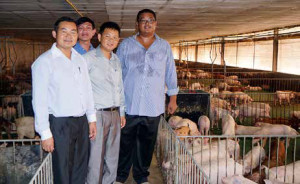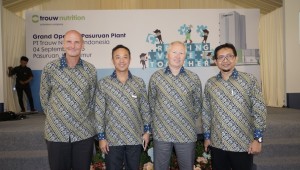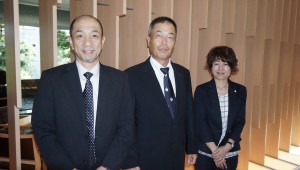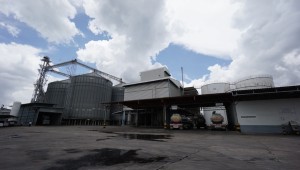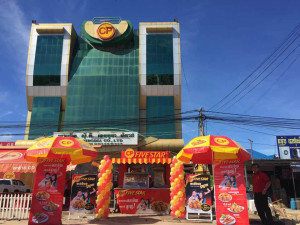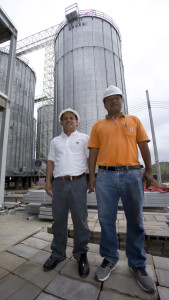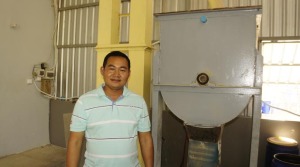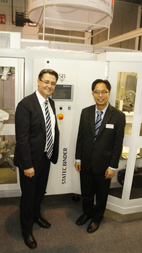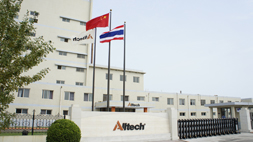Trang Wattana to market commercial hog feed
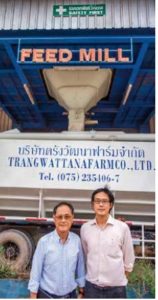
(left) Raewat and Ekarat Pokawattana
Trang Wattana plans to enter the pig feed business while at the same time increasing finishing and breeder capacity to retain cost competitiveness, according to Raewat Pokawattana, manag- ing director and founder.
As it prepares for GMP and HACCP accreditation in Q3 this year, the com- pany plans to rev up its feed mill capac- ity to 35 tonnes/hour, up from 20 tonnes/ hour, to keep up with business growth.
In the second half of 2017, it will launch “New Choice,” a formulation that cov- ers hog needs at all stages, ranging from creep feed, pre-starter, starter, grower, finisher, and sow feed for both gestation and lactation.
Ekarat Pokawattana, general manager, said the company currently produces around 1,800 tonnes/month for inter- nal use. The increased capacity will also help it serve nearby contract growers.
A single-barrel, three-tonnes/hour extruder line produces full fat soy and corn for internal use. Production deci- sions hinge on the spot price of full fat soy and corn.
It operates two pellet mills with com- bined capacity of 35 tonnes/hour and a mash line, 20 tonnes/hour. Average Pellet Durability Index (PDI) is above 80%. Fines at a rate of 20-40% negate the benefits of pelleted feed, he added.
Macro and micro scales are routinely calibrated. The weighing bridge is cali- brated every two years as required by Thailand’s Ministry of Commerce.
Grower and finisher feed is antibiotic free. Piglet and creep feed is produced in a separate line. It uses a single-shaft rib- bon mixer with a CV below 10. The mixer is thoroughly cleaned when changing for- mula from piglet feed to other products.
Feed is mainly corn-soybean based. Wheat is included when the price is right. Phytase is a staple enzyme, but NSP enzymes are sometimes incorpo- rated depending on the substrates used in the formula.
Fish meal is used as a protein source, with total volatile nitrogen (TVN) test- ing to determine quality. Acceptable ingredients should have a TVN of 120 mg N/100g. Natural anti-oxidants are applied as stabilizers.
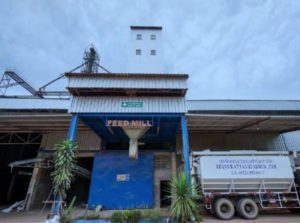
Trang Wattana feed mill
The plant operates six days/week and routinely runs preventive maintenance. Operators are equipped with safety gear such as hard hats, protective shoes, ear plugs and more. Fiberglass bucket eleva- tors prevent ignition. The plant is fitted with jet filters at the grain dump pit and hammer mills. Dust collectors are used at sieving and bagging areas.
Critical control points include poten- tial foreign material entry points, reten- tion time and temperature, and animal protein quality, especially with fish meal and meat and bone meal.
Sieves and magnets are installed to trap tramp iron at receiving points as well as hammer mill and pellet mill feeder chutes. READ MORE
……………………………………………
Betagro crafts niche in premium pet food
completion of a 1.2-billion- baht pet food plant will enable Betagro Group subsidiary Pet Focus Co to capture a larger share of the premium pet food and pet treat market across Asia, accord- ing to Vasit Taepaisitphongse, CEO of Betagro Group.
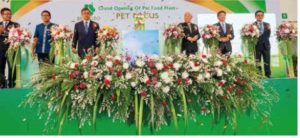
The grand opening of Pet Focus Co was presided over by (2nd left) Panu Yamsri, Lopburi governor, (3rd left) Dr Yukol Limlamthong, former deputy prime minister and minister of Agriculture
and Cooperatives, (4th left) Dr Chaivat Taepaisitphongse, Betagro chairman, (5th left) Vanus Taepaisitphongse, president (right), Vasit Taepaisitphongse, CEO, and (left) Chayanon Kittayachaweng, COO.
Pet Focus targets becoming Thailand’s 3rd largest dry pet food player by 2018 with a 10% market share, up from its cur- rent 5%.
At present, the plant produces around 4,000 tonnes/month mainly for the Thai market with 30% exported to Indonesia, Malaysia, Japan, Vietnam, Myanmar and the Philippines.
Pet Focus projects double-digit growth via development of innovative products, noted Mr Vasit.
Full capacity of 11,000 tonnes/month will be reached sometime between 2018 and 2019. More production lines are to be added later.
Pet Focus, which has achieved annual growth of 20% in the domestic market in recent years, expects 60% sales growth by the end of 2017. This will be achieved by adding 1,000 new sales channels at pet shops, vet clinics, modern trade and pet farms across the country, up from 2,000 in 2016. READ MORE
………………………………………………………………………
Thaifoods Group eyes 19% sales growth in 2017
THAIFOODS GROUP (TFG) is stepping up a planned shift into primary and further processing in a bid to thwart risks to its business model from market volatility.
The company is well on its way to recovery after suffering steep losses in recent years, said Cherdsak Kukiattinun, COO.

Cherdsak Kukiattinun
In fiscal year 2016, the company reported 1.4 billion baht in net profit, which was a big turnaround from the 1.5 billion baht that it lost in 2015. So far in 2017, it has earned 20.7 billion baht, up from 17.5 bil- lion baht during the same period last year.
It has invested in two hog slaughter- houses in Khon Kaen and Chachoengsao and a poultry further processing plant.
With a larger sales force, better market penetration countrywide and favorable chicken prices, TFG expects to report even better earnings in 2017.
Mr Cherdsak said the company plans to establish new distribution depots in 40 strategic markets to increase its acces- sibility to end users and shore up gross margins.
Hog prices in 2017 have leveled off amid a slump in exports of live animals, but the company still sees opportunity for sub- stantial swine business growth. It plans to leverage additional primary process- ing capacity to reduce risks from price swings. TFG successfully grew its hog business by 20% in 2016. READ MORE
…………………………………………………………………….
Bangkok Ranch Plc takes the food business plunge
WITH THE OPENING OF A NEW SUBSIDIARY, Bangkok Ranch Plc will begin offering pre-cooked items and meals to the food service industry, according to Joseph Suchaovanich, vice-chairman and man- aging director of Asia and Asia Pacific.
The new facility operated by Food City Co worth 500 million baht located in Pathum Thani will be ready to roll in the second half of 2017. The plant will sup- ply further cooked products, duck meat- balls, duck patties, smoked duck breast, roast duck, salami and various ready-to- eat meals.
Highly versatile and equipped with four production lines for raw, grilled, steamed, and roasted meat, the facility can also do pre-dusting, battering and ready-to-eat meals including soup and fried rice.
Besides the core business of duck meat, Food City also makes noodles and won- ton wrappers with 30 tonnes/month capac- ity to supply food services, wholesalers, quick-service restaurants and more.
It recently opened a restaurant in Udon Thani and a coffee shop at Bangkok Ranch’s head office. READ MORE
……………………………………………………………………………
Egg transfer – A necessary and delicate task
Transfer management is one of the most delicate and important tasks at the hatchery. At the same time, it needs to be efficient and smooth.
When eggs are transferred from a setter, they go from an upstanding position to a lateral position once they are placed in the hatcher. This will allow the chick to move can be single or multi-stage, but all the eggs will ultimately be transferred to a single-stage hatcher.
Putting the eggs in a different environment for hatch (all in – all out) is important for hygiene because hatching generates a lot of residue and chick down, which may promote the spread of contamination.
The single age chamber allows for managing a temperature step-down program to avoid overheating and dehy during and after hatch. The setters drating the chicks, which helps maintain good chick quality.
At transfer time, the egg shell is very fragile due to the utilization of part of the calcium for skeleton development, thus making the egg vulnerable to transfer cracks. When the eggs crack during transfer, the egg will dehydrate and the internal membrane will stick to the baby chick—disrupting the movements of the bird and hatch. If the transferring is too rough, it can immediately kill the embryo by mechanical damage.
———————————————————————-
Modeling hindgut fermentation in chickens and pigs
By Tom Weigand, M.S., Fermentation
Scientists at DIAMOND V began developing the Intestinal Activity Modifier Model (IAMM) in 2007. Working at the Research and Innovation Center (RIC) on the campus of Kirkwood College in Cedar Rapids, Iowa, USA, they built on the science and technology developed for their successful Rumen Activity Modifier Model (RAMM).
The goal of both models is to mimic anaerobic fermentation and other microbiological activity in vitro – in the lab, not in animals — and thereby control for critical variables that affect the gut environment. Such models are a great advantage in isolating and studying the effects of existing Diamond V products as well as new prototypes.
For example, Original XPC™ had wellproven beneficial effects in ruminants, like dairy cows and beef cattle. But it also had beneficial effects in monogastrics, Chairman John Bloomhall, who was then President and CEO, got the IAMM project going by asking, “Why?”Modeling hindgut fermentation in chickens and pigs
———————————————————-
Making room for feed additives in piglet diet formulation
By Dr. Attila Kovacs, Global Product Line Manager–Acidifiers, Biomin Holding GmbH
Organic acid use in piglet diets can be considered routine nowadays. Yet, high levels of organic acids in feed formulation take up a lot of otherwise useful space in the feed.
Replacing a portion of organic acids with a more powerful additive can create room to further enhance feed formulation or add more economical raw materials at no additional cost.
Swine producers apply organic acids to feed mainly to combat microbial and fungal contamination that causes the deterioration of feed and to decrease the pH in animals’ stomachs. Constant treatment with organic acids has the added benefit of preventing recontamination of feed, whereas methods such as heat treatment do not.
A number of factors support the rationale for dietary acidification for juvenile animals, especially weaning pigs. At weaning, piglets often register limited digestive and absorption capacity, typically due to insufficient hydrochloric acid and pancreatic enzymes secretion. Add on top of this, stress associated with the weaning process, sudden feed consistency and environmental changes – all of which can have a negative effect on the digestion, feed absorption and intestinal microflora of the piglets.Making room for feed additives in piglet diet formulation.Making room for feed additives in piglet diet formulation
———————————————————————————————————-
Export ban on soybean meal hurts industry and consumers, says TVO
Encouraging more soybean crushing capacity and opening up new export markets for soybean meal will help dampen the rising price of vegetable oil, said Supachai Vitayatanagorn, Thai Vegetable Oil Plc (TVO) executive vice president.
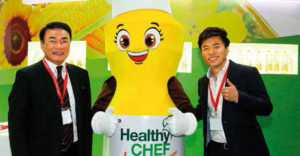
Vichit and Supachai Vitayatanagorn at the recent Thai Fex 2016
Mr Supachai said that lifting the government- imposed ban on soybean meal exports would result in a win-win scenario, with increased exports resulting in cheaper prices for vegetable oil consumers in the short term, and long-term gains for local crushers seeking to boost production.
Instead of trying to suppress vegetable oil prices locally, the Thai government should be helping the industry create a more stable vegetable oil supply, he added.
The country has banned soybean meal exports. This however has put a lid on local crushing capacity which is running at only 60%. What’s more, vegetable oil exports account for only 10-15% of the total capacity.
——————————————————————–
Thai Foods Group Plc on the path to recovery
For Chirdsak Kukiattinun, TFG’s new chief operating officer and director, managing a multi-billion-baht operation is the same whether the products come with shiny bells and whistles or hooves and feathers.
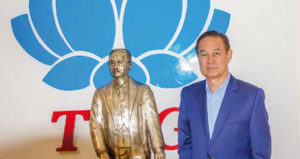
Chirdsak Kukiattinun
Mr Chirdsak, who previously worked for the fast moving telecom and IT industry at a company with an annual sales in excess of 30 billion baht/year, sees a vibrant future at TFG.
Since he took over the top job at TFG in February, he has been tasked with bringing the agro-industrial giant back from the brink of potential insolvency. He’s confident that success is well on track.
“2016 is the beginning of the turnaround,” said Mr Chirdsak.
TFG is already returned in the black due to cost efficiency and more favorable prices for chicken and pork and a growing export business. Gone is the former dismal outlook, and now TFG eyes turnover of 30 billion by 2018, with average growth of 20-25% per annum.
———————————————————————————————————-
Kaona Poultry ducks the competition with heavier broilers
Instead of building a bigger chicken farm, why not grow bigger chickens?
Operating from a remote location in Thailand’s Northeast, Kaona Poultry has carved out a unique niche by supplying heavy birds that tip the scales at over 2.8 kg and offer a meat yield 30% higher than the average 38 day-old broiler.
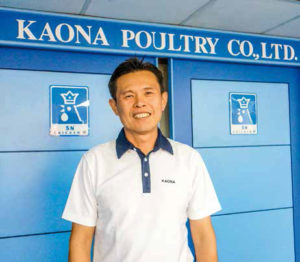
Suchet Triyangkulsri
Suchet Triyangkulsri, vice managing director, said raising bigger broilers takes a little longer, but it’s worth the extra time and effort.
Rearing period for the males is stretched to 42-45 days. Even so, the company averages an FCR below 1.79, body weight 3.4 kg, liveability 96%, with a stocking density below 10 birds/sq m.
With today’s genetics and enough time, the birds could potentially be grown into 4 kg monsters, he added.
“Raising large-size birds is a daunting task. But it is rewarding. We may have fewer customers, but the broilers are still profitable. Also, we have extra time to think about quality,” said Mr Suchet.
Thai Viet Swine Line revs up feed and hog business in central Vietnam
Thai Viet swine Line, A SUBSIDIARY OF THAI FOODS GROUP PLC, is expanding its breeding herd and feed mill capacity in anticipation of strong market growth.
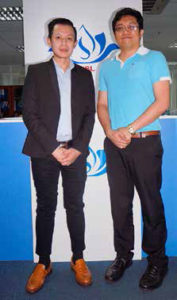
Rachan Arayawongchai and Dr Kanisorn
Rachan Arayawongchai, general director, said TVSL’s goal is to become a market leader supplying high quality feed and superior hog genetics in central Vietnam.
Feed business: Thinking outside the box
According to conventional thinking, feed mills should be located near the grain. That is why most millers in Vietnam operate in Ho Chi Minh City or Hanoi. Some started their feed businesses in parallel with hybrid corn promotion and contract grower systems.
As recently as five years ago, Da Nang was considered a small, remote city based on seasonal tourism with poor access for shipping live animals by road or animal feed via sea. Few saw potential for growth, and even fewer would have invested business capital there.
Where others saw only obstacles, TVSL saw an opportunity for a business startup with low sunk costs. A mill was leased and finishing units operated by contract growers were built.
————————————————————————————————————–
Mori Max: A new alternative for fighting antimicrobial and antiviral resistance
According to recent trials, Mori Max enhances immunity and reduces viral shedding without interrupting piglet digestion and improves sow health status.
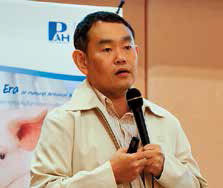
Assoc-Prof Dr Athipoo Nuntaprasert
Assoc-Prof Dr Athipoo Nuntaprasert from the Faculty of Veterinary Science of Chulalongkorn University said that positive results were found in controlled field trials in Thailand that saw 40 piglets supplemented with Mori Max at a rate of three kg/tonne for 30 days during the nursery period.
Researchers tested the product at a finisher farm in Ratchburi province that was infected with PED, PRRS and PCV2.
Some 40 piglets were put in four pens, each containing 10 piglets. The objectives were to observe growth performance and determine whether Mori Max was capable of inhibiting PRRS, PED and PCV2 shedding.
Fecal samples were taken to analyze PED shedding at two and four weeks.
Blood samples were collected on days 14, 28, 42 and 56.
At four weeks of age, five piglets were euthanized and samples taken to examine lesion score and mesenteric lymph nodes to detect porcine circovirus type 2 (PCV2).
After the four-week trial, the group supplemented with Mori Max achieved ADG of 340.7g for an FCR of 1.71 vs 328.9 g and 1.74 for the control group.
—————————————————————————————————————
M’s Pig targets 30% market share in Cambodia by 2018
M’s Pig ACMC Cambodia Co Ltd plans to double its sow herd to 20,000 head by 2018, according to company president Dr Mong Reththy, who is also a Cambodian senator.
By the middle of this year, another 4,000 sows will be added to the company’s current 6,000 sows for a total of 10,000 through expansion at its own facilities and by expanding its contract growing operation. M’s Pig will operate 40% of the total and the balance will be handled by contract growers.
A new 20-hectare site was being prepared for a new breeder unit, but low prices have caused the project to be delayed. Instead, M’s Pig has opted to invest in a new feed mill.
Hog output will be raised mainly by adding 60 new farms and 160 contract growers to its existing network of business alliances.http://www.feedlivestock.com/ms-pig-targets-30-market-share-in-cambodia-by-2018/
—————————————————————————————–
Betagro Southern updates product mix
With an eye on becoming Thailand’s leading brand, Betagro Group Plc has invested heavily in boosting production. But it’s about more than just cranking out more meat and eggs.
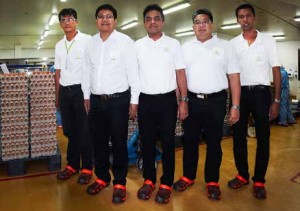
Trirat Thongplod (center) accompanied by (from left) Prasit Ratanaphan, Nipon Noiwibol, Surachet Tongboonlorm and Niphon Laor-gor
Along with upgrades to its poultry and pork processing plant in Pattalung and a rebuilt layer farm in Songkhla, the company has adjusted its business model to optimize capacity utilization to build a stronger business overall, according to Trirat Thongplod, vice-president for regional business.
By increasing the number of regional offices and shops to accommodate its growth strategy, Betagro’s revamped business operations will be geared more towards higher margin meat and food products.
Currently, Betagro distributes meat and egg products via 86 regional office branches, and up to 160 Betagro shops are to be opened by the end of 2016.http://www.feedlivestock.com/betagro-southern-updates-product-mix/
——————————————————————————–
Betagro’s new layer farm redefines welfare and efficiency
The 400-million-baht renovation of a layer farm in Rattaphum district, Songkhla, will be completed in Q3, 2016, said Surachet Tongboonlorm, assistant vice-president.
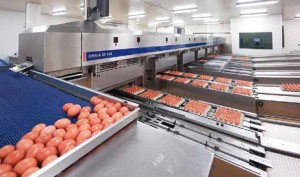
Egg grading facility at Rattanaphum, 30 km northeast of Hat Yai with 45,000 eggs/hour
capacity, serves customers within 300 km.
Efficiency and welfare are built into the design and workflow of the fully automatic operation. Drinking, feeding, lighting, ventilation, egg delivering and manure removal systems are all fully automated so that only two workers are able to handle 43,200 birds.
In the past, a single worker was thought to be capable of looking after no more than 6,000 birds, he noted.
There are four pullet houses, each holding 64,000 birds. The day-old layer chicks are delivered from Betagro’s breeder farm in Pakchong, Nakhon Ratchasima – 1,200 km away from the farm.http://www.feedlivestock.com/betagros-new-layer-farm-redefines-welfare-and-efficiency/
————————————————————————————–
Nutreco unveils start a state-of-the-art premix plant in East Java
Nutreco invests US$9 million to build a new premix plant in Surabaya in order to meet robust demand in East Java and fast growing markets in the Far East, according to Knut Nesse, CEO.
“This investment is crucial for Nutreco’s Asia growth strategy of sustaining leadership and growing the market in Asia and Indonesia in particular,” he said.
Product safety is the top priority. The new plant will adopt Nutrace, Nutreco’s proactive quality assurance program that assures feed-to-food safety.
“You are not allowed to call the company ‘Nutreco’ if quality is compromised,” said Mr Nesse.
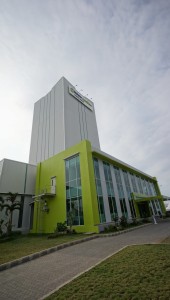
Trouw Nutrition’s latest premix plant in Pasuruan Industrial Park, Surabaya. The plant has a working space of 2,200 sq m, tower height 40 metres, and a double-deep racking system with 900 pellet positions or around 900 tonnes of stocking capacity
All ingredients will be subject to rigorous testing to prove that they live up to Nutreco’s high standards of quality control and quality assurance system.
“We are offering customers peace of mind. We provide customers and stakeholders in the feed and food chain with safe, traceable and impeccable products,” he said.
Haiko Zuidhof, general manager of Trouw Nutrition Indonesia, said Surabaya was selected because it will enable Trouw to increase its level of service, cut lead time for customers in the East Java area, and save significantly on logistic costs.
With mills in East Java revving up their capacity, it is likely that the eastern part of the island will be the main market driver. At the same time, seaport infrastructure in East Java is well developed and less congested.
The location offers a distinct logistical advantage, which means that the mill will provide better services for customers in Makassar, Surawesi and outlying markets in East Java as well as offshore clients.http://www.feedlivestock.com/nutreco-unveils-start-a-state-of-the-art-premix-plant-in-east-java/
—————————————————————————————————-
Japan’s Ghen Corporation dominates parent stock trade
Decades of superior quality, products and technical support have put Ghen Corporation at the top of Japan’s layer breeder industry with a market share of over 90% for PS and day-old layer chicks.
Shuji Watanabe, president, said the company’s success is also based on a long record of offering the right products to meet diverse needs. The company’s product portfolio includes Hy-Line, Lohmann and H&N products, whether white, brown or tinted egg shell.
The products are flawless in terms of egg quality, eggshell quality, efficiency, livability, amount and dryness of feces. However, feces management could become a critical point holding producers back from taking up new expansion projects due to stricter environmental regulations.
PS demand in Japan is 1.2 million birds a year. The Hy-Line Brown dominates with nearly 100% of the brown egg market. Hy-Line Sonya Gray, a tinted egg variety, has been the dominant tinted egg layer in Japan for many years. The LSL Classic and LSL Lite, both white egg layers, occupy a major proportion of the white egg market while W-36, a white egg layer, is popular in the more temperate regions of Japan.http://www.feedlivestock.com/japans-ghen-corporation-dominates-parent-stock-trade/
—————————————————————————————————-
Thai soybean crusher PAS Export & Silos Co., Ltd. targets better logistics
With the goal of making a good location even better, PAS Export & Silos will build a new 4,000-tonne transit warehouse in Ayutthaya to improve logistic efficiency as it targets 15% sustained growth per annum.
Raw materials can be delivered to the plant via ship, truck and train, said Krit Pornamnuaysub, managing director. Whole soybeans can be shipped to Laem Chabang and then transferred to smaller boats that are towed to its warehouse in Ayutthaya or they can be trucked directly from Laem Chabang. However, transitioning cargoes from Laem Chabang and shipping them via barges on the Chaophraya River to Ayutthaya is more cost effective.
The new transit warehouse being built in Ayutthaya in Q3 this year will reduce both time spent on empty backhauls and overall travel distance. As a result, the average delivery cost for shipping products to customers in the upper north will be less than 0.30 baht/kg. In comparison, he estimates that it costs his competitors around 0.55-0.70 baht/kg to cover the same route.http://www.feedlivestock.com/thai-soybean-crusher-pas-export-silos-co-ltd-targets-better-logistics/
—————————————————————————————————-
Anti-inflammatory effects support growth performance in farm animals
By Dr. Tobias Steiner, Phytobiotics GmbH, Eltville, Germany
Optimizing health and performance is key to profitability in animal production. Therefore, appropriate tools of growth promotion are necessary now and in future. As such growth promotion should be defined as supporting the animal to achieve the highest possible level of performance and feed efficiency while maintaining appropriate health.
In commercial conditions, farm animals are continuously affected by various challenges, such as high stocking density, feed change, heat stress or pathogenic challenge. Immune response is necessary to cope with such challenges or eliminate pathogens from the body. However, these defense mechanisms are costly to performance since they cause a partitioning of nutrients towards the immune system, which ultimately makes production less efficient.
Inflammatory challenges are costly to performance
The gastrointestinal tract fulfills two main functions: On the one hand, it is the location where feed is digested and nutrients are absorbed. On the other hand, it has a barrier function and represents a complex system of immune defense.
Within the gut immune system, inflammatory processes are a key part of the biological response of the tissue to harmful challenges. Inflammatory response may result from feed (a phenomenon called “metabolic inflammation”) or pathogenic challenge. However, inflammation comes with a significant physiological expense due to the activation of several mechanisms that require energy and nutrients.http://www.feedlivestock.com/1268-2/
—————————————————————————————————-
Non-coated, intrinsically heat stable enzymes: Needs, challenges and opportunities
Dr. Ajay Bhoyar – Senior Manager, Global Poultry Marketing, Novus International, Inc.
Dr. Drew Lichtenstein – Manager, Enzymes and Specialty Products Development, Novus International, Inc.
The upward trend in commercial animal feed conditioning temperatures aimed at improving pellet quality, as well as enhancing feed hygiene, continually tests the stability limits of various feed additives. Enzymes, in particular, are susceptible to potential heat-mediated loss of catalytic activity. As a result, the feed industry continues to explore opportunities for retaining the desired level of enzyme activity in the face of ever harsher feed manufacturing conditions.
Enzymes are proteins and tend to lose their catalytic activity at high temperatures. The three-dimensional structure of proteins, held together by various types of chemical bonds, is critical for such catalytic activity. This complex structure may be destroyed as the temperature raises to the point where the protein unfolds and cannot refold again, a process commonly known as denaturation. The process of enzyme denaturation is somewhat similar to boiling an egg: proteins in the egg subjected to heat during cooking remain in a fluid state (i.e. soft-boiled egg) until the temperature rises to a certain point at which the proteins irreversibly denature causing them to precipitate out of solution (i.e. hard-boiled egg). In the process of manufacturing pelleted feed, it is the “conditioner” which presents the most challenging environment for the enzyme to survive without denaturing.
Enzyme product manufacturing companies have applied three approaches to protect enzymes against harsh pelleting conditions: (1) application of a coating material to dry enzyme products, (2) genetic manipulation of the enzyme to make it more heat stable, and (3) the discovery of intrinsically heat stable enzymes with or without genetic modifications.
Ideally, encapsulation or application of a protective coating to the enzyme must protect the enzyme from the steam conditioning process, with temperatures reaching 90 degrees Celsius or higher, as well as from the actual pelleting process. However, quick release of the enzyme from the coating in the gastrointestinal tract of the animal is essential to ensure optimum efficacy. Coating technologies are the most widely used enzyme protection technology today, but are a compromise between increased heat stability and reduced enzyme release.http://www.feedlivestock.com/non-coated-intrinsically-heat-stable-enzymes-needs-challenges-and-opportunities/
—————————————————————————————————-
SUCRAM®, THE WHITE-GOLD TASTE ENHANCER FROM PANCOSMA
By Clement Soulet
The Pancosma & Associates group opens the doors to our high tech world-class laboratory dedicated to palatant and taste enhancing products.
What answers do we have to address modern day challenges within the feed industry? 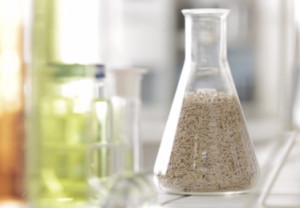 Pancosma, for almost 70 years, have created, designed and delivered the most cutting edge, practical and effective feed additives.
Pancosma, for almost 70 years, have created, designed and delivered the most cutting edge, practical and effective feed additives.
Take for example Taste enhancers. Part of the palatant family and core business of Pancosma, and more specifically sweet taste enhancers which remain at the forefront of our strategy.
It is in Geneva, at the primary research center of our group, that the latest innovations are created, tested, and formulated. With our original factory situated right next to the HQ, things are not what they appear to be. Inside this architecturally designed traditional Swiss industrial building, is located the pioneering laboratory where groundbreaking products are developed in the field of taste enhancers: raw materials are balanced and transformed into high added value solutions for the feed industry worldwide. Pancosma are always striving to be one step ahead of market expectations, as demonstrated by SUCRAM, the range of innovative sweetening solutions.http://www.feedlivestock.com/news-2/sucram-the-white-gold-taste-enhancer-from-pancosma/
……………………………………………………………………………………………
CP Cambodia targets growth and agility
CP Cambodia Co Ltd has set an ambitious revenue growth target of over 10% per year by improving logistics and economies of scale at its livestock, feed and food businesses, according to Uthai Tantipimolphan president.
The company’s food segment, although relatively new, has a promising future. CP Cambodia’s food operations unit, which already supplies over 2,300 tonnes/year of sausages, meatballs, bacon and ham and more, is poised for further growth as new products are introduced amid a stepped up focus on local market research and development.
Mr Uthai added that livestock production, the company’s core business, will grow through expanded farm operations, while retail sales will increase by adding additional points-of-sale and more branch offices in fast growing markets to reach more customers.
CP Cambodia (CPC) has business operations in 26 provinces across the country. It plans to open three new branch offices in various provinces in 2015, up from 14 currently.
Five Star grilled chicken kiosks will be expanded to 250 outlets across the
country by December of this year, up from the current 160 outlets. At least 500 kiosks will be opened by 2017, he added. http://www.feedlivestock.com/news-2/cp-cambodia-targets-growth-and-agility/
……………………………………………………………………………….
Charoen Pokphand Cambodia builds second mill in booming Pailin
CPC’s new plant in Pailin plans to hit the ground running.
With the first of its international standards accreditation set for Q3, 2015, it is preparing to follow up that goal with TPM and ISO accreditation by Q2, 2016. The rest of this year will be spent in preparation for further accreditations, said Werayuth Chanarath, assistant vice-president of CPC’s feed production business.
“Feed will be traceable. We will put feed and food safety in Cambodia on par with international standards,” he said.
That lofty goal is not only aimed at impressing domestic consumers. By achieving world class quality, CPC will then be able to develop its capability for exports.
A Safety Health and Environment (SHE) framework will be in place before the plant begins producing feed this year, he added.
The new feed mill, worth over US$20 million, sits on a 17-acre site in Pailin province, a border town between Cambodia and Thailand. Of total production, some 60% will be used internally and the balance sold to customers in northwestern Cambodia.
The plant produces mash feed for layers and pelleted feed for broilers and hogs. It will gradually shift from mash layer feed to crumbled feed to improve feed efficiency. http://www.feedlivestock.com/news-2/1065-2/
………………………………………………………………………………….
Incubation distress can lead to leg problems in broilers
G.K.Rathinam
On some occasions the incidence of splayed (spread out) or twisted legs in chicken flocks increases. These issues can be linked to incubator and especially hatcher temperature and ventilation conditions.
Observations:
The incidence of splayed legs in chicks and poults at hatch is very low, normally no more than 0.35 to 0.50%, but it can increase on some occasions.
Birds with this condition have one or both legs splayed laterally from the coxofemoral joint and are unable to stand.
Sometimes, the problem is only observed on the farms and constitutes another cause of culling during the first three weeks of age. http://www.feedlivestock.com/news-2/incubation-distress-can-lead-to-leg-problems-in-broilers/
………………………………………………………………………………………………………
Delacon – more efficient and sustainable animal production with phytogenic products
Efficiency and safety in animal nutrition were the top themes at the Delacon Performing Nature Symposium recently held in Bangkok. 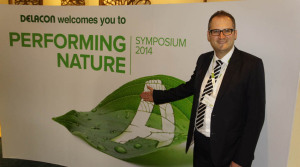
On the sidelines of the symposium, entitled “Plan A: Efficiency and Safety in Animal Nutrition”, Markus Dedl, CEO, stated that the global feed market was being driven by two major factors: consumers who demand wholesome and safe food, and the soaring world population.
“In the consumerism era, every consumer is a CEO. Why? Because they are the ones that decide what is going to happen” he said. <read more>
——————————————————————————————-
Phytogenic feed additives as solution for challenges in livestock production
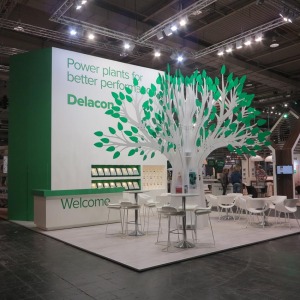 Between sixty and seventy percent of the total costs in livestock production are feed costs and they continue to rise. Not only the economic factor, but also animal health, product quality and environmental protection are important issues concerning feeding of farm animals. Meaningful and targeted alternatives are sought – and found. The Upper Austrian family business Delacon, world leader in phytogenic (purely natural) additives, presented its innovations as well as a new Corporate Design at EuroTier, the world’s leading trade fair for livestock production, which took place from November, 11th to 14th 2014 in Hannover.
Between sixty and seventy percent of the total costs in livestock production are feed costs and they continue to rise. Not only the economic factor, but also animal health, product quality and environmental protection are important issues concerning feeding of farm animals. Meaningful and targeted alternatives are sought – and found. The Upper Austrian family business Delacon, world leader in phytogenic (purely natural) additives, presented its innovations as well as a new Corporate Design at EuroTier, the world’s leading trade fair for livestock production, which took place from November, 11th to 14th 2014 in Hannover.
As a driver of innovation and ideas in agriculture, the EuroTier has a lot to offer. Every two years, the global animal husbandry industry meets at this leading trade fair in Hanover. With 156,000 visitors from more than 100 countries, the EuroTier 2014 has far exceeded expectations, says the German Agricultural Society (DLG) who organized the trade fair. <read more>
——————————————————————————————-
Switzerland’s Pancosma targets brand breakthrough
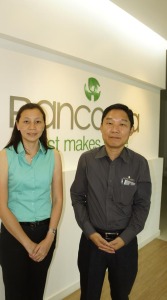
(Left) Patcharin Maneeroj, sales manager – South East Asia and Chaitat Bunteralert, deputy managing director Pancosma Thailand Co., Ltd.
With a new office in Thailand, Pancosma is ready to offer a complete line of the latest products supported by top-notch marketing and customer service, according to Chaitat Bunteralert, deputy managing director of Pancosma Thailand Co Ltd.
The Bangkok office is the Swiss firm’s first business unit to open in Southeast Asia, and comes after the opening of a China office. That location, however, is combined with a blending plant that will serve customers in China only, he noted.
Pancosma has recruited marketing, sales and support teams for its Bangkok venture, and will register new products due to roll out beginning in the second half of 2014.
The office in Samut Sakhon, 30 km south of Bankgok, is large enough to keep 200 tons of stock on hand, but can also arrange air freight to deliver products directly from Europe and Canada to Bangkok in case of shortages. <read more>
——————————————————————————————-
Sihanoukville’s Mitsam Lanh Farm bets on growing demand for better chicken
Supplying superior quality chicken to more affluent consumers in Cambodia’s capital city is the key to an ambitious Cambodian poultry farmer’s expansion plans.
Dr Bun Sidoeun, owner of Mitsam Lanh, said his company which currently produces around 4,000 birds/week is targeting weekly output of 16,000 birds/week by 2015.
Apart from its main markets in Sihanouville, Kampong Cham, Kampote and nearby cities, Mitsam Lanh plans to penetrate the Phnom Penh market by targeting customers who prefer good quality, hygienic meat. <read more>
——————————————————————————————-
Cambodia’s Hok Hieng Group plans food and retail venture
Along with plans for a herd and feed mill expansion, Hok Hieang is developing new food businesses and marketing channels aimed at retail and supermarkets.
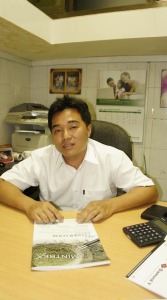 Chan Sothea, general manager of Hok Hieng, said the company which supplies around 75 hogs/day recently took over a processing plant with a capacity of 20 head/day, mainly split carcasses. Part of the meat goes to its sausage plants where the products are primarily hotdogs, white pork sausage and Chinese-style sausages. The plant can supply two tonnes of combined products/day.
Chan Sothea, general manager of Hok Hieng, said the company which supplies around 75 hogs/day recently took over a processing plant with a capacity of 20 head/day, mainly split carcasses. Part of the meat goes to its sausage plants where the products are primarily hotdogs, white pork sausage and Chinese-style sausages. The plant can supply two tonnes of combined products/day.
At present, it distributes fresh pork through Lucky Supermarket, Cambodia’s main supermarket chain.
Custom-cut products for food service customers and retailers are in the works, and its preparing to open 15 butcher shops in the Phnom Penh area to sell fresh meat and sausages in 2015. <read more>
———————————————————————————————
Alltech sees opportunity for ‘smart’ foods in latest research
 There are smart people and smart countries.
There are smart people and smart countries.
What do they have in common?
Fish, according to Alltech President and founder Dr Pearse Lyons.
Thanks to their country’s wise investment in an Oil Fund, virtually everyone in Norway is now a millionaire.
But with their oil production trending downward, the northern European nation of five million endowed with thousands of kilometres of pristine coastline is looking to harness the power of aquaculture in order to become the world’s second largest exporter of fish after China.
Norway currently produces 1.3 million tonnes of farmed salmon at a value of almost US$10 billion. With a cost of production at around $3, it sells for roughly $7/kg.
“Aquaculture is becoming a bigger export from Norway than oil. That’s incredible,” said Dr Lyons. “And they say that our industry isn’t exciting.” <read more>
————————————————————————
Statec Binder opens office in Bangkok
Austria’s Statec Binder recently opened an office in Bangkok to support sales and customer service in Thailand and Vietnam.
Gerhard Steinmayr, executive manager of key accounts, said the Bangkok office is currently serving customers in both markets, but plans to expand its business across Southeast Asia in the near future.
The company has named Attawit Armincen as its managing director. The Bangkok office which opened in January 2014 is run by a marketing and after-sales team with extensive experience in fertilizer, petrochemicals, sugar, rice and the animal feed industry.
Presently, Statec Binder has the largest market share in Korea, India and Thailand. It plans to penetrate further in Vietnam, Myanmar, Indonesia, Philippines and Taiwan. <read more>
———————————————————————————-
Alltech China to triple annual Optigen output
Alltech’s plant in Tianjin plans to triple its output of a coated, slow release urea called Optigen to 18,000 tonnes/year, according to Matt Kwok, operation manager, Alltech China
The Tianjin plant, which serves the Chinese market, is the largest production base for Alltech in Asia. In the future, the 27,000-sq-m plant was acquired in 2009 and a further over $5 million was to increase output, assay capability and build new warehouses.
The plant is 35 minutes away from Tianjin seaport by truck, It is also close to Beijing, where Alltech recruits many graduates from top universities.
A central distribution centre was completed in early 2014 at the warehouse. <read more>

